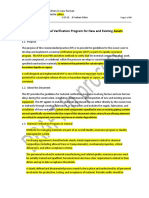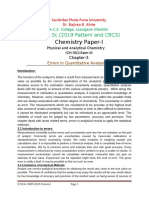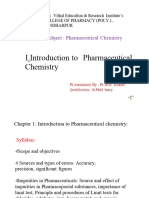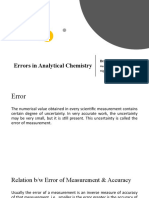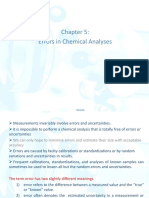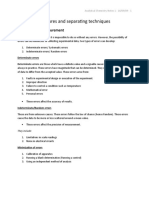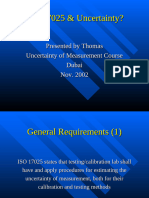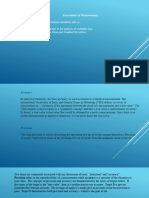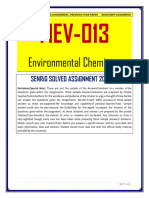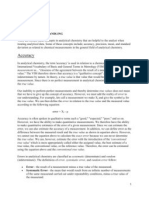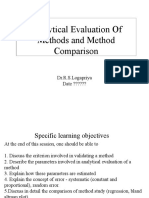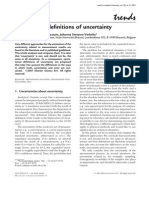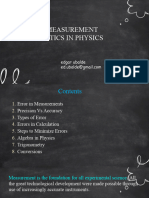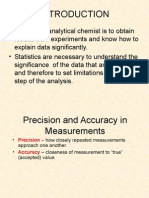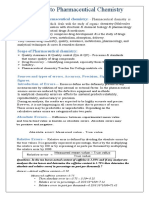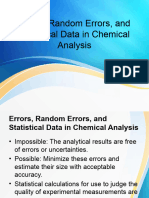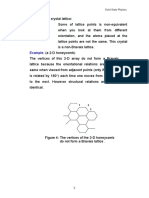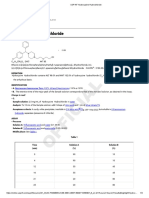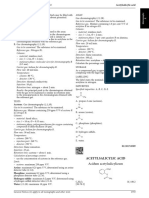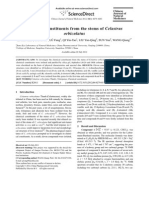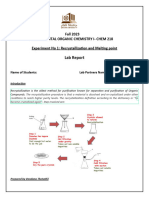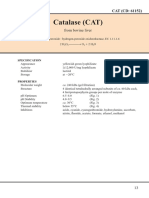Errors-Mynotes
Errors-Mynotes
Uploaded by
Ravikumar VejandlaCopyright:
Available Formats
Errors-Mynotes
Errors-Mynotes
Uploaded by
Ravikumar VejandlaOriginal Description:
Original Title
Copyright
Available Formats
Share this document
Did you find this document useful?
Is this content inappropriate?
Copyright:
Available Formats
Errors-Mynotes
Errors-Mynotes
Uploaded by
Ravikumar VejandlaCopyright:
Available Formats
CONCEPT OF ERROR
Errors arise as a result of variation between calculated (measured) value and true
(accepted) value. Errors are inevitable and are associated with every measurement resulting in
uncertainty in the calculated value.
The reliability of the result increases with a decrease in the variation between the
calculated value and true value. This can be attained by repetitive measurements.
In cases where true value is not known, the arithmetic mean of the measured values is
considered to be the true value.
Standards certified by the National Bureau of Standards (NBS) are considered to be the
true values in the evaluation of new analytical methods.
Variation between the standard value of NBS and the calculated value is termed as an error.
Errors are expressed either in absolute terms or in relative terms.
1. Absolute error (Eabs): It is the variation between the calculated value and true value.
Therefore. Eabs = Calculated value - True value
2. Relative error: It is widely used in the determination of the accuracy of a measurement
and is expressed in terms of percentage.
Accuracy: The accuracy of a determination may be defined as the concordance
between the data and the true / most probable value. It is the agreement between the
data and true value (or) It refers to the closeness of a single measurement on its true
value.
Precision: The precision of a determination may be defined as the concordance of a
series of measurements of the same quantity. The mean deviation/relative mean
deviation is a measurement of precision. It is a measure of “the reproducibility of data”
with a series of results. Results within a series when to agree closely with one another
are said to be precise.
*Precise results are not necessarily accurate.
*Precise always accompanies accuracy.
*Precision expresses the reproducibility of measurements.
*Accuracy expresses the correctness of a measurement.
Classification of errors
I. Determinate / Systematic error
a) Size of the sample
(i) Constant error (ii) Proportional error.
b) Accuracy of Measurement.
(i) Instrumental / Reagent error
(ii) Methodical error
(iii) Personnel / Operational error
II. In-determinate / Random error
III. Gross / Erratic error.
Prepared by Dr.VRK, Professor & HOD, Dept. of Analysis.
I. Determinate / Systematic error
As the name implies, determinate errors occur due to an assignable cause. They are
unidirectional, reproducible and are often predictable.
Example: Improper calibration and weighing of the compound.
In many cases, they are predicted and corrected. Determinate errors result in bias in the
calculated values.
Characteristics of Determination / systematic errors
1. They can be an attribute to a definite or assignable cause.
2. They are unidirectional with respect to the true value.
3. Reproducible.
4. They are often predictable. The magnitude of error can be estimated.
5. Errors can be defined.
6. Occur with certain regularity.
Types of Determinate/Systemic
a) Based on Size of the Sample:
(i) Constant Errors: The magnitude of the constant error is independent or does not
change with the sample of the sample taken for analysis. With constant errors, the
absolute error doesn’t vary when the size of the sample taken for analysis is changed,
whereas relative error varies with the sample size. The constant error becomes significant
when the size of the sample taken for analysis decreases.
Example: (a) Additional reagent required during titration to bring colour change.
(b) Impact, of loss due to solubility, on results in gravimetric analysis.
(ii) Proportional error: The magnitude of proportional error depends or varies with the size
of the sample taken for analysis. With proportional error, the absolute error varies with
the size of the sample taken for analysis, whereas the relative error doesn’t vary with the
sample size. The presence of reactive contaminants is the most common cause for the
occurrence of proportional error.
Example: In the iodometric determination of chlorate, the presence of another oxidant like
bromate leads to proportional error.
b) Based on Accuracy of Measurement
Determinate or Systemic errors are broadly classified into three types.
(i) Instrumental and Reagent Errors:
These errors occur mainly because of the limited accuracy of instruments and due to the
presence of impurities in chemicals that are used in the analysis. Measuring devices such as a
pipette, burette, volumetric flask act as a potential source of errors. Lack or improper
calibration also results in errors.
Calibration of glass apparatus is usually done at 20°C, hence while analysing the temperature
at which the analysis is carried out should be noted and necessary adjustments should be made.
If the working temperature varies from the temperature at which calibration is done, the
calculated value may be incorrect.
Some of the common sources of instrumental and reagent errors include:
(a) Improper calibration of glassware
Prepared by Dr.VRK, Professor & HOD, Dept. of Analysis.
(b) Impurities present in reagents that are used for analysis
(c) Improper selection of equipment
(d) Faulty balance weights.
Note: These errors can be minimized by careful calibration, using appropriate instruments, by
using reagents free from impurities etc.
(ii) Methodical Errors
These are the most serious errors which occur during chemical analysis and are difficult to
detect. Instrumental and personal errors can be detected and minimized but methodical errors
cannot be ruled out completely. Methodical errors are inherent in the method and cannot be
minimized unless the conditions of analysis are altered.
Some of the common sources of errors include:
(a) Co-precipitation, precipitation or post-precipitation
(b) Nature of the reagents
Eg: Errors occur if proper care is not taken while weighing hygroscopic substances.
(c) Non-ideal behaviour of reagents used in the analysis.
(d) Solubility of precipitates, decomposition reactions, and post-precipitation reactions during
gravimetric analysis results in error.
Eg: The determination of nitrogen by Kjeldahl's method lacks precision because of
incomplete conversion of nitrogen compounds with conc. H,SO, to yield ammonium sulphate.
This is found to be true in pyridine compounds. These errors can be minimized by subjecting
the sample to reducing conditions.
Note: Methodical errors cannot be ruled out completely because they are physical in nature.
However, they can be minimized to a certain extent.
(iii) Personnel and Operative Errors
This class of errors occur due to inaccurate judgements made by analyst due to bias or
negligence.
Examples: (a) Inappropriate methods employed for transferring solutions.
(b) Incomplete drying of a sample before weighing.
(c) Inability of a person to distinguish colour changes in visual titrations.
During analysis, many a situation arise where the analyst has to make a judgement regarding
the measurement or weighing etc. Any prejudice is shown by the analyst often leads to
systemic error.
For example: Estimating accurate value when the scale lies between two divisions.
Detection of Determinate/Systemic Errors
The presence of systemic errors results in bias, they should be detected and corrected
immediately. Systemic errors can be detected by any of the following ways.
1. Perform the analysis of samples of known concentration. If the observed value matches
with the known answer, then systemic errors are absent.
2. Analyze blank sample, if the observed value is not zero, then the presence of systemic
error is confirmed.
3. Analyze the sample of same concentration by two or more different methods. If the results
do not coincide, then the presence of error in one or more methods is indicated.
Prepared by Dr.VRK, Professor & HOD, Dept. of Analysis.
4. Analyze the sample of same concentration by different persons either by same or different
methods.
If the variation between an observed value and the accepted value is high, then systemic
errors exist.
Methods of Minimizing Determinate/Systemic Errors
a) Calibration: Calibration is defined as the process of establishing a relationship
between the measuring device and units of measure. This is achieved by comparing
the output or result with that of a standard possessing known measurement
characteristics.
Precision and reliability of results depend upon the degree of accuracy of the measurements
and this enhances the need for calibration.
b) Blank Titration: Conducting the analysis under experimental conditions without the
inclusion of sample to be analyzed is termed blank titration. The following
conclusions can be drawn by conducting a blank titration.
Effect of impurities present in reagents and containers
The amount of standard solutions is essential to bring about an endpoint when the analysis is
carried out in the presence of a sample.
However, a large blank correction is insignificant as it reduces the precision.
c) Determination Establishing Controls: This involves the determination of a standard
substance, containing the same constituent as in an unknown sample, under
experimental conditions. The standard substance should contain the same amount of
constituent as in the unknown sample.
Many standard samples analyzed by skilled analysts are commercially available as primary
standards, BCS certified reference materials etc.
d) Independent Method of Analysis: This involves carrying out analysis by different
methods and comparing the results obtained by different methods. The results are said
to be accurate if they are concordant.
If the results obtained by the above two different methods (i) and (ii) are concordant, they are
accurate within small limits of error.
e) Parallel Determinations: They indicate the precision of analysis. In this method, the
values obtained for the constituents which are present in not too small quantity should
not differ from the results obtained by more than 3 parts per thousand. If they differ
largely, analysis is carried out repeatedly until satisfactory concordance is attained.
In general, duplicate or triplicate determinations are sufficient and an agreement between them
indicates the presence of a constant error. They further indicate that accidental errors or
variations of determinate error are similar or closely similar in parallel determination.
f) Standard Addition: This technique is widely applicable to physicochemical procedures
such as polarography, spectrophotometry etc. This method involves the addition of
known amounts of a constituent to be determined to the sample which is then analyzed
for the total amount of constituent present.
This technique can be done alternatively by a series of standard additions of constituent
samples and the determination of analyte concentration from the graph.
g) Internal Standards: This method is of great value in chromatographic determinations. It
involves the addition of a constant (fixed) amount of reference material to a series of
Prepared by Dr.VRK, Professor & HOD, Dept. of Analysis.
known concentrations of the sample analyzed. The ratio of peak size of the reference
material to a series of known concentrations are plotted against concentration.
The graph should yield a straight line. Unknown concentration is estimated by adding the same
quantity of reference material and determining the point at which ratio lies on the concentration
scale.
II. Indeterminate/Random Errors
Indeterminate errors occur due to various causes. They are inevitable and random in nature
and result in high and low results with equal chances. Though they cannot be eliminated, they
do not affect the accuracy but exhibit a lack of precision.
They cannot be ascribed to any known causes and cannot be predicated with regard to
magnitude or direction as a result of which the operator has little control over them.
However, they can be minimised by repeated measurements until the observed value is close
to the true or accepted alue.
Examples
(a) Gravimetric analysis involving multiple separations, filtrations and washings stand a good
chance for the occurrence of random errors.
(b) Loss of sample during analysis
(c) Variations in humidity, temperature etc., lead to fluctuations in weighing thereby causing
an error.
(d) Inability of the analyst in recognizing minute changes in readout device.
(e) Noise and changes in the electric circuit.
Characteristics of Indeterminate/Random Error
1. They cannot be ruled out completely.
2. They cannot be predicted.
3. They do not affect accuracy.
4. Lack of precision
5. They follow a random distribution.
6. They can be related to small random errors with the overall effect being error.
III. Gross / Erratic error:
These are different from determinate and indeterminate errors. These errors occur
occasionally and are not repeated in similar determinations making results either high or
low.
Source:
1. Spillage of some part of the sample.
2. Fluctuations in balance room during weighing.
3. Recording wrong values.
4. Mistakes during computation.
These errors can be minimised by repeating the experiment. The gross or erratic errors are
always in wide disagreement with theoretically determined values or previous values.
Prepared by Dr.VRK, Professor & HOD, Dept. of Analysis.
FUNDAMENTALS OF VOLUMETRIC ANALYSIS
It is a general term for a method in quantitative chemical analysis in which the
amount of a substance is determined by the measurement of the volume that the
substance occupies. It is commonly used to determine the unknown concentration of a
known reactant. Volumetric analysis is often referred to as titration, a laboratory
technique in which one substance of known concentration and volume is used to react
with another substance of unknown concentration.
Requirement for Volumetric Analysis
For use of chemical reactions in volumetric methods, the reaction should fulfill
some ofthe requirements.
These are as follows:-
1. The reaction should be simple & expressed by a well-defined chemical equation.
2. The reaction should be rapid.
3. The reaction must proceed to completion when an equivalent amount of
standard solution has been added. This gives satisfactory endpoint detection.
4. There must be some sharp change in either t h e physical or chemical
properties of the solution at the equivalence point.
5. The reaction should have some simple method for the detection of t h e
endpoint orequivalence point of the titration.
The requirements above are not always realized for every volumetric
method.
Many volumetric methods can also be applied where one or more of the
above requirements are not ideally met.
CLASSIFICATION OF VOLUMETRIC METHODS OF ANALYSIS
Volumetric Methods involve chemical reactions.
Depending upon the type of reaction involved, the volumetric method has been
classified as:
1) Neutralization (Aqueous –acid-base) titrations.
2) Non-aqueous titrations.
3) Precipitation titrations.
4) Complexometric titrations.
5) Redox titrations.
1) Neutralization/aqueous Acid-Base Titrations:
It involves a neutralization reaction in presence of water as solvent.
2) Non-aqueous Titrations:
It involves the reaction between acid & base in presence of non-aqueous
i.e. organic solvents.
3) Precipitation Reactions:
It involves the reaction leading to precipitate formation. It includes the methods
where the reacting substance & standard solution react to yield a precipitate or a
Prepared by Dr.VRK, Professor & HOD, Dept. of Analysis.
slightly soluble salt as the primary reaction product.
NaCl + AgNO3 ----- > NaNo3 + AgCl
4) Complexometric Titrations:-
It includes all the methods wherein the reacting substance & the standard
solutionreact to form a soluble but very slightly dissociated complex substance.
It is based on complex formation reactions mainly EDTA titrations.
5) Redox Titrations:-
These titrations involve simultaneous oxidation reductions reactions.
It includes all the methods wherein reacting substance is oxidized or reduced
by the standard solution.
METHODS OF EXPRESSING CONCENTRATION
In all the techniques of qualitative analysis, the use of solutions requires
some bases for the expression of solution concentration.
All the systems of concentration expression have fundamentally similar
bases with respect to weight relationships of solute & solvent, but the
actual method of expression of concentration should take on some
convenient & specific form.
1) Normality:
The normality of a solution is defined as the no. of gram equivalent present perliter of
the solution. It is denoted by “N”.
Normality = No. Of gram equivalents/Volume (in liters)
Gram Equivalent (Equivalent weight):
The equivalent weight of an acid is that weight of it, which contains 1gm of
replaceable hydrogen.
An equivalent weight of monobasic acids is equal to its molecular weight.
An equivalent weight of a dibasic or a tribasic acid is 1/2 & 1/3 respectivelyof its
molecular weight.
Equivalent weight for acid = Molecular weight/Basicity
Similarly, the Equivalent Weight of a base is the weight of the substance which
contains one replaceable hydroxyl group.
Equivalent weight for base = Molecular weight/Acidity
Examples:
1. HCl eq.wt. = Moleculer weight/1
= 36.5/1 = 36.5
2. H2SO4 eq.wt. = Molecular Weight/Basicity
= 98/2 = 49
3. NaOH eq.wt. = Molecular Weight/Acidity
= 40/1 = 40
4. Na2CO3 eq.wt. = Molecular Weight/Acidity
= 106/2 = 53
Prepared by Dr.VRK, Professor & HOD, Dept. of Analysis.
2) Molal Concentration: (m)
It is represented by ‘m’. It is rarely used in the analytical technique.
The molality of the solution is given by the number of moles of solute per kg of solvent.
3) Molar Concentration (M):
It is represented by ‘M’. The molar conc. of the solution is the number of moles of solute
per liter of solution.
Volume may be changed due to changes in temperature, so it is temperature-dependent.
4) Formal concentration:
Some substances do not exist in the molecular form whether in solid or solution form.
They remain in ionic form in solid-state as well as in a solution.
In such cases instead of molecular weight, t he formula weight is used in t he preparation
of t he solutionand its concentration is expressed in terms of formality.
Example: NaCl, FeCl3 can be defined very simply as a number of formula weight of a solute
per liter of solution.
F= [weight of solute (in gm)/ volume of solution (in L)] x Formula weight
Formal solutions generally show changes in formality where t h e volume changes a r e
associated with temperature.
5) Parts per million (ppm):
Parts per million is frequently used to express the concentration of very dilute
solutions and is expressed as ‘ppm’.
Cppm = [(Mass of solute (in gm)/ mass of solution (in gm)] x 106 ppm
These terms are also employed to express the concentration of impurities in
pharmaceuticals. Parts per billion (ppb) is very rarely used.
6) Percent Concentration
Conc. is many-a-times expressed in terms of percent (parts per hundred).
Percent composition of a solution can be expressed as:
%w/w = [weight of solute (in gm)/weight of solution (in gm)] x 100
%v/v = [volume of solute (in ml)/volume of solution (in ml)] x 100
%w/v = [weight of solute (in gm)/volume of solution (in ml)] x 100
PRIMARY AND SECONDARY STANDARDS
Very pure reagents are used for standardization.
A solution whose concentration is accurately known is called a standard solution.
The accurate weight of t h e reagent is taken, dissolved, and diluted to t h e
exactly known volume, and concentration is calculated on a theoretical basis.
The substance of high purity used in the preparation of Standard solution is known
as Primary Standard Solution.
Prepared by Dr.VRK, Professor & HOD, Dept. of Analysis.
Primary Standard Substances – Ideal Characteristics:
It must be easy to obtain, purify, dry, and preserve in a pure state.
It should be 100% pure although 0.01 to 0.02 impurities are tolerable if accurately
known.
Stable at atmospheric condition.
Should not be hygroscopic.
It should show high equivalence weight in order to reduce weighing error.
Reaction with Standard Solution should be stoichiometric and practically
instantaneous.
Can be determined by simple indications.
There should not be any difference between the endpoint and theoretical
equivalence point.
It should be readily soluble under the conditions.
It should not have water or hydration.
It is not always possible to satisfy all the requirements of a primary standard but the
requirements mentioned above should be net at all this as closely as possible.
Commonly used Primary Standards are Sodium carbonate, Potassium hydrogen
phthalate, Succinic acid, Benzoic acid, Adipic acid (In acid-base titrations);
Potassium dichromate, Copper sulfate, (In redox titration); Silver, Silver nitrate,
Sodium chloride, potassium chloride (in precipitation titrations)
Concentrated HCl can also be used as a primary standard.
SECONDARY STANDARD SUBSTANCES
There are the Substances used for the standardization and whose concentration
has beendetermined by comparison with the primary standards.
Example: An unknown solution of HCl can be determined by two methods.
(a)By using analytical grade Na2CO3(Primary Standards) (b)By using
Standard Solution of NaOH(Secondary Standard).
Definition of terms
1) Volumetric Analysis: Which Involves the preparations, storage, and measurement
of the volume of chemicals for analysis
2) Volumetric Titrimetry: Quantitative chemical analysis which determines the
volume of a solution of accurately known concentration required to react
quantitatively with the analyte (whose concentration is to be determined). • The
volume of titrant required to just completely react with the analyte is the TITRE.
3) Titration: A process in which a standard reagent is added to a solution of analyte
until the reaction between the two is judged complete Primary Standard A reagent
solution of accurately known concentration is called a standard solution.
4) Standardization: A process to determine the concentration of a solution of known
concentration by titrating with a primary standard
5) Endpoint: The point at which the reaction is observed to be completed is the
endpoint. The endpoint in the volumetric method of analysis is the signal that tells
Prepared by Dr.VRK, Professor & HOD, Dept. of Analysis.
the analyst to stop adding reagent and make the final reading on the burette. The
endpoint is observed with the help of an indicator.
6) Equivalent point: The point at which an equivalent or stoichiometric amount of
titrant is added to the analyte based on the stoichiometric equation
The Equipment: Volumetric analysis involves a few pieces of equipment:
1) Pipette – for measuring accurate and precise volumes of solutions
2) Burette – for pouring measured volumes of solutions
3) Conical flask – for mixing two solutions
4) Wash bottles – these contain distilled water for cleaning equipment
5) Funnel – for transfer of liquids without spilling
6) Volumetric flasks – a flask used to make up accurate volumes for solutions of
known concentration
The Process - Preparation: Two solutions are used:
The solution of unknown concentration and the solution of known concentration – this
is also known as the standard solution. Write a balanced equation for the reaction
between your two chemicals. Clean all glassware to be used with distilled water. The
pipettes and burettes will be rinsed with the solutions you are adding to them
Process – The Setup:
a) The burette is attached to a clamp stand above a conical flask. The burette is filled
with one of the solutions (in this case a standard solution)
b) A pipette is used to measure an aliquot of the other solution (in this case a solution
of unknown concentration) into the conical flask
c) Prepare a number of flasks for repeat tests. Last, an indicator is added to the conical
flask
Process – The Titration:
(i) Read the initial level of liquid in the burette
(ii) Turn the tap to start pouring out the liquid of the burette into the flask.
(iii) Swirl the flask continuously. When the indicator begins to change colour slow the
flow.
(iv) When the colour changes permanently, stop the flow and read the final volume.
(v) The volume change needs to be calculated (and written down).
(vi) This volume is called a titer
(vii) Repeat the titration with a new flask now that you know the ‘rough’ volume
required. Repeat until you get precise results
Prepared by Dr.VRK, Professor & HOD, Dept. of Analysis.
You might also like
- API RP 578 3rd Edition, Re-Written in New FormatDocument24 pagesAPI RP 578 3rd Edition, Re-Written in New FormatSoo100% (1)
- CH 1 - ERRORSDocument31 pagesCH 1 - ERRORSmalathy100% (1)
- Errors in Quantitative AnalysisDocument23 pagesErrors in Quantitative AnalysisDENNIS YEGON MASTERS100% (1)
- ErrorsDocument13 pagesErrorsFayiz ArfanNo ratings yet
- Unit 3: Errors in Chemical Analyses: Topic OutlineDocument15 pagesUnit 3: Errors in Chemical Analyses: Topic OutlineJherby TeodoroNo ratings yet
- 1introduction To Pharmaceutical ChemistryDocument41 pages1introduction To Pharmaceutical ChemistryBad BoyNo ratings yet
- Module 1 Fundamentals of Pre Analyses UNIT 1: Theory of ErrorsDocument94 pagesModule 1 Fundamentals of Pre Analyses UNIT 1: Theory of ErrorsJessica ZafraNo ratings yet
- CHM 101 OCT 31 Lecture 2Document10 pagesCHM 101 OCT 31 Lecture 2Mark JonesNo ratings yet
- Analytical Chemistry (Theory)Document10 pagesAnalytical Chemistry (Theory)Jagadeesh EllilNo ratings yet
- Errors in Chemical AnalysisDocument21 pagesErrors in Chemical AnalysisIshrat YaqoobNo ratings yet
- Errors and Treatment of Analytical Data by K.n.s.swami..pdf474Document26 pagesErrors and Treatment of Analytical Data by K.n.s.swami..pdf474Ravi ChauhanNo ratings yet
- Accuracy, Precision, Errors, Significant FighuresDocument63 pagesAccuracy, Precision, Errors, Significant FighuresvasantiNo ratings yet
- Errors in Chemical AnalysisDocument7 pagesErrors in Chemical AnalysisRoyNo ratings yet
- Precision Is The Closeness of Results To Others Obtained in Exactly The Same WayDocument5 pagesPrecision Is The Closeness of Results To Others Obtained in Exactly The Same WayUok123No ratings yet
- Aspects of Analysis PDFDocument61 pagesAspects of Analysis PDFKowla100% (1)
- Unit 2 Evaluation of Analytical Data IDocument15 pagesUnit 2 Evaluation of Analytical Data INathanian75% (4)
- Module 2 PDFDocument26 pagesModule 2 PDFMaries San PedroNo ratings yet
- Errors in Analytical ChemistryDocument15 pagesErrors in Analytical ChemistryMohammad Sabir HussainNo ratings yet
- Analytical Concepts of ErrorDocument2 pagesAnalytical Concepts of Errormechemist11No ratings yet
- Errors in Pharmaceutical AnalysisDocument4 pagesErrors in Pharmaceutical Analysisv2749598No ratings yet
- CN 5Document21 pagesCN 5Jonah PasicaranNo ratings yet
- Te Analytical Chemistry 1Document9 pagesTe Analytical Chemistry 1saeed rahulNo ratings yet
- Errors in Chemical AnalysesDocument6 pagesErrors in Chemical AnalysesCHRISTINE JOY RETARDONo ratings yet
- Analytical Concepts of ErrorDocument2 pagesAnalytical Concepts of Errormechemist11No ratings yet
- Analytical Chemistry Notes 1Document4 pagesAnalytical Chemistry Notes 1Wayne RobinsonNo ratings yet
- What Is Uncertainty!Document174 pagesWhat Is Uncertainty!SudharsanNo ratings yet
- Introduction To Pharmaceutical ChemistryDocument20 pagesIntroduction To Pharmaceutical ChemistryAnuvrat YelneNo ratings yet
- Treatment of Bias in Estimating Measurement Uncertainty: Gregory E. O'Donnell and D. Brynn HibbertDocument9 pagesTreatment of Bias in Estimating Measurement Uncertainty: Gregory E. O'Donnell and D. Brynn HibbertaureaborosNo ratings yet
- Means and Standard DeviationDocument8 pagesMeans and Standard DeviationTishonna DouglasNo ratings yet
- Analytical Errors & Validation of Analytical ProceduresDocument61 pagesAnalytical Errors & Validation of Analytical ProceduresMtw WondNo ratings yet
- ERRORSDocument5 pagesERRORS267adhithyanNo ratings yet
- CXG - 054e 2021Document7 pagesCXG - 054e 2021Nguyen Hien Duc HienNo ratings yet
- CH 5Document33 pagesCH 5nimet eserNo ratings yet
- 2-Evaluation of Analytical Data - BinDocument74 pages2-Evaluation of Analytical Data - BinRegie Ornopia SultanNo ratings yet
- Errors in Chemical Analysis BPHTDocument22 pagesErrors in Chemical Analysis BPHTMaria FlorinaNo ratings yet
- Mev 013 (Em) Solved Assignment 2021Document9 pagesMev 013 (Em) Solved Assignment 2021ubaidmajeedmir5No ratings yet
- ErrorsDocument6 pagesErrorsSubhash DhungelNo ratings yet
- Errors When Handling Data in Analytical ChemistryDocument8 pagesErrors When Handling Data in Analytical ChemistryFrank ChikaniNo ratings yet
- Methods Comparison 5th Sept'18 DR PriyaDocument65 pagesMethods Comparison 5th Sept'18 DR Priyaamit daniel100% (1)
- Theory of errorsAADocument5 pagesTheory of errorsAAmrunmayeeNo ratings yet
- Chapter 1 Errors in Chemical AnalysisDocument23 pagesChapter 1 Errors in Chemical Analysisgunawan refiadiNo ratings yet
- Operational de Nitions of UncertaintyDocument13 pagesOperational de Nitions of Uncertaintyrtorrez79No ratings yet
- Laboratory Errors in Analytical LaboratoryDocument30 pagesLaboratory Errors in Analytical LaboratorySathish Vemula100% (1)
- Errors in Measurement Mathematics in PhysicsDocument21 pagesErrors in Measurement Mathematics in PhysicsMark RamosNo ratings yet
- Analytical Chemistry Lecture 3Document37 pagesAnalytical Chemistry Lecture 3S JNo ratings yet
- Introduction To Pharmaceutical - ChemistryDocument17 pagesIntroduction To Pharmaceutical - Chemistryabhay sharmaNo ratings yet
- Lecture Notes 19 - Accuracy and PrecisionDocument5 pagesLecture Notes 19 - Accuracy and PrecisionSurendra RamkissoonNo ratings yet
- 2-Data Handling in Analytical MeasurementDocument58 pages2-Data Handling in Analytical MeasurementMary joy DavidNo ratings yet
- Errors in Chemical Analysis - Lecture 3Document20 pagesErrors in Chemical Analysis - Lecture 3Acidri AbdulkarimNo ratings yet
- Error in AnalysisDocument10 pagesError in AnalysisMohamed Babiker Suliman100% (1)
- Physics Project by DurvaDocument10 pagesPhysics Project by DurvaDurva YerunkarNo ratings yet
- Statistical Treatment To The Data Notes PDFDocument9 pagesStatistical Treatment To The Data Notes PDF398 -Sahifa SayedNo ratings yet
- VALIDACIJA TechnicalNote17apr09Document9 pagesVALIDACIJA TechnicalNote17apr09dabicdarioNo ratings yet
- Statistics For Anal. Chem. - Lecture Notes - Xu Ly So LieuDocument157 pagesStatistics For Anal. Chem. - Lecture Notes - Xu Ly So LieuLiên Hương100% (1)
- 1B40 DA Lecture 1Document8 pages1B40 DA Lecture 1Roy VeseyNo ratings yet
- RTEnd ESDocument21 pagesRTEnd ESUmar RashidNo ratings yet
- Accuracy and ErrorDocument5 pagesAccuracy and Errormahesh bhattaraiNo ratings yet
- Term Paper: Types of ErrorsDocument16 pagesTerm Paper: Types of ErrorsShivam K MaheshwariNo ratings yet
- Basic Statistical ToolsDocument43 pagesBasic Statistical ToolsHaytham Janoub HamoudaNo ratings yet
- WINSEM2022-23 BBIT206L TH VL2022230501238 Reference Material I 20-12-2022 Accuracy and PrecisionDocument21 pagesWINSEM2022-23 BBIT206L TH VL2022230501238 Reference Material I 20-12-2022 Accuracy and PrecisionGravity JaiNo ratings yet
- Biology Experiment #10Document2 pagesBiology Experiment #10Grace JosephNo ratings yet
- Determination of Mesalamine in Bulk Drug and Tablet Formulation PDFDocument5 pagesDetermination of Mesalamine in Bulk Drug and Tablet Formulation PDFcavalo2080No ratings yet
- Crystal Structure 2Document6 pagesCrystal Structure 2Cazimir BostanNo ratings yet
- USP-NF Hydroxyzine HydrochlorideDocument4 pagesUSP-NF Hydroxyzine Hydrochlorideeldridatech pvt ltdNo ratings yet
- Ejercicios EquilibrioDocument3 pagesEjercicios EquilibrioLorena Mazo TorresNo ratings yet
- Chemistry Teach Yourself Series - Topic 1 - PHDocument11 pagesChemistry Teach Yourself Series - Topic 1 - PHMia FENTONNo ratings yet
- Course Plan For CLPC 24 - January 2021: Upon Completing The Course, The Student Will Be Able ToDocument5 pagesCourse Plan For CLPC 24 - January 2021: Upon Completing The Course, The Student Will Be Able ToNishanth ChandranNo ratings yet
- Chemistry Cheat Sheet (2010RR)Document3 pagesChemistry Cheat Sheet (2010RR)Ruiyi Liu100% (1)
- Experiment 3: Neutralization Capacity of Commercial Antacid AcidDocument10 pagesExperiment 3: Neutralization Capacity of Commercial Antacid AcidfizaNo ratings yet
- Mixture Separation TechniquesDocument13 pagesMixture Separation TechniquesOsmany MadrigalNo ratings yet
- SepaDocument2 pagesSepaRobert DelfinNo ratings yet
- Answer: D: Selected/modified From Brown Et Al: Chemistry The Central Science, 10e, 12e, 13e TestbanksDocument3 pagesAnswer: D: Selected/modified From Brown Et Al: Chemistry The Central Science, 10e, 12e, 13e Testbanksفاطمة كليبNo ratings yet
- BIOLOGY Investigatory ProjectDocument17 pagesBIOLOGY Investigatory ProjectShruti GarjeNo ratings yet
- Acid-Base Exam Questions 3Document18 pagesAcid-Base Exam Questions 3Jake RobinsonNo ratings yet
- Vol Anal GrapesDocument8 pagesVol Anal GrapesBright OgwoNo ratings yet
- Acid AcetilsalicilicDocument3 pagesAcid AcetilsalicilicIli MarinaNo ratings yet
- InertSustain AX-C18 Catalog - ENDocument12 pagesInertSustain AX-C18 Catalog - ENquimicontayNo ratings yet
- Qualitative and Quantitative Analysis of Air Sample Using GCXGCDocument23 pagesQualitative and Quantitative Analysis of Air Sample Using GCXGCRaquel Tejero OlivaNo ratings yet
- Solid State PhysicsDocument55 pagesSolid State PhysicsPoth BaliyanNo ratings yet
- Acid-Base BalanceDocument51 pagesAcid-Base Balanceabbasfarida2001No ratings yet
- Chemical Constituents From The Stems Of: Celastrus OrbiculatusDocument5 pagesChemical Constituents From The Stems Of: Celastrus OrbiculatusTuan PhamquocNo ratings yet
- REport 1 Recrystalliation and Melting PointDocument4 pagesREport 1 Recrystalliation and Melting Pointmaya 1DNo ratings yet
- Practical 1: Study of Laboratory Reagents: A SolutionDocument17 pagesPractical 1: Study of Laboratory Reagents: A SolutionPalNo ratings yet
- Acid Base & Salts Test 1Document6 pagesAcid Base & Salts Test 1awaisNo ratings yet
- Catalase (CAT) : From Bovine LiverDocument4 pagesCatalase (CAT) : From Bovine Liver幸福No ratings yet
- AccQ Tag SolutionDocument1 pageAccQ Tag SolutionNgọc Việt NguyễnNo ratings yet
- Musa Paradisiaca Var. Sapientum Musa Paradisiaca Var. Sapientum Musa Paradisiaca Var. SapientumDocument7 pagesMusa Paradisiaca Var. Sapientum Musa Paradisiaca Var. Sapientum Musa Paradisiaca Var. SapientumAnnisya Shafira Al-FadlillahNo ratings yet
- Ammonia ISE Technical NoteDocument5 pagesAmmonia ISE Technical Notefahim khattakNo ratings yet
- The Solid State Previous Qns. and AnswersDocument7 pagesThe Solid State Previous Qns. and AnswersSooraj SubhashNo ratings yet
